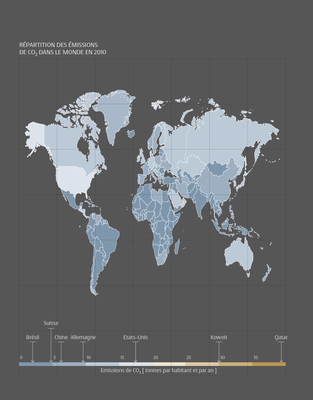Does Switzerland emit comparatively little CO2 thanks to its very “clean” electricity?
Compared internationally, despite its low-carbon electricity,Switzerland does not have a good track record of CO2 emissions. It therefore needs to reduce its greenhouse gas emissions, particularly inthe transport and construction sectors.
Thanks to low-carbon hydraulic and nuclear power plants, Swiss electricity is one of the world’s “cleanest,” with only 33 grams of CO2 emitted for every kilowatt-hour of electricity produced. This is called “carbon intensity,” i.e., the amount of CO2 emitted from the combustion of fossil fuels emitted per unit of electricity (gCO2/kWh). Countries that produce electricity primarily from coal-fired power plants have a much higher carbon intensity: 800 to 1000 gCO2/kWh in Eastern Europe, Australia, China and India. As for the European electrical mix, its carbon intensity averages 300-350 gCO2/kWh.
But please note: a distinction must be made between electricity produced and electricity consumed in Switzerland. Electricity produced in Switzerland has a carbon intensity of 33 gCO2/kWh. But the electricity we consume has a higher average carbon intensity because of the coal- and gas-fired power plants generating the electricity that we import from Germany.
Electricity accounts for only one quarter of our energy consumption. The remaining three-quarters comes from combustibles and fuels, almost exclusively of fossil origin (heating oil, natural gas, petrol, diesel, kerosene), burned for heating, industrial applications and mobility. Compared internationally, Switzerland has a high per capita consumption of fossil fuels. One of the reasons for this is its fleet of fuel-intensive vehicles [→ Q34].
Swiss citizens emit about 4.5 tonnes of CO2 per year, which is about the same as the global average. The largest contributors are currently the countries on the Arabian Peninsula (20 to 30 tonnes per capita per year), followed by Australia and the USA (15 tonnes) [→ see figure below]. Moreover, these national estimates consider only CO2 emissions occurring in the countries themselves, but do not include emissions from imported products. Rich countries, such as Switzerland, import many consumer goods that have generated emissions in the countries where these goods were produced [→ Q9].
Despite its very clean electricity, Switzerland is therefore not among the best performers internationally. As CO2 emissions do not stop at borders, and the impacts of global warming are largely globalised, Switzerland has a duty to participate in the global effort to reduce greenhouse gas emissions [→ Q5].

References
- Banque Mondiale (2019)
- Banque Mondiale (2019). Emissions de CO₂ (kt). [ONLINE]. Available at: https://donnees.banquemondiale.org/indicateur/EN.ATM.CO2E.KT.
- Delbosc, Keppler & Leseur (2007)
- Delbosc, A., Keppler, J. & Leseur, A. (2007). Croître sans réchauffer? L’intensité carbone des économies développées.
- Jolliet, Saadé & Crettaz (2010)
- Jolliet, O., Saadé, M. & Crettaz, P. (2010). Analyse du cycle de vie: comprendre et réaliser un écobilan. PPUR Presses polytechniques et universitaires romandes.
- Office fédéral de l'énergie (OFEN) (2019)
- Office fédéral de l'énergie (OFEN) (2019). Statistique globale de l’énergie 2018. OFEN.
- Office fédéral de l'environnement (OFEV) (2017)
- Office fédéral de l'environnement (OFEV) (2017). Indicateurs de l’évolution des émissions de gaz à effet de serre en Suisse 1990-2015.
- Swiss Centre for Life Cycle inventories (2019)
- Swiss Centre for Life Cycle inventories (2019). Ecoinvent. [Online]. Available at: www.ecoinvent.org. Retrieved from www.ecoinvent.org/database7